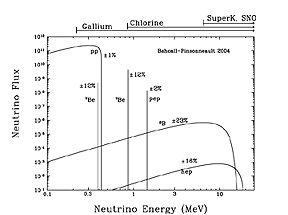 Solar Models and Solar Neutrino Oscillations
Solar Models and Solar Neutrino Oscillations
 The predicted solar neutrino energy spectrum. The figure shows the
energy spectrum of solar neutrinos predicted by the BP04 solar model.
For continuum sources, the neutrino fluxes are given in number of
neutrinos cm-2s-1 MeV-1 at the
Earth's surface. For line sources, the units are number of neutrinos
cm-2s-1. Total theoretical uncertainties are
shown for each source. To avoid complication in the figure, we have
omitted the difficult-to-detect CNO neutrino fluxes.
The predicted solar neutrino energy spectrum. The figure shows the
energy spectrum of solar neutrinos predicted by the BP04 solar model.
For continuum sources, the neutrino fluxes are given in number of
neutrinos cm-2s-1 MeV-1 at the
Earth's surface. For line sources, the units are number of neutrinos
cm-2s-1. Total theoretical uncertainties are
shown for each source. To avoid complication in the figure, we have
omitted the difficult-to-detect CNO neutrino fluxes.
 Solar Models: An Historical Overview
Solar Models: An Historical Overview


 Why Do Solar Neutrino Experiments Below 1 MeV?
Why Do Solar Neutrino Experiments Below 1 MeV?
 Astrophysical
Neutrinos: 20th Century and Beyond
Astrophysical
Neutrinos: 20th Century and Beyond
 Standard
Solar Models
Standard
Solar Models
 Solar Neutrinos: Where We Are, Where We Are Going
Solar Neutrinos: Where We Are, Where We Are Going
 Solar Neutrinos: Solved and
Unsolved Problems
Solar Neutrinos: Solved and
Unsolved Problems
 How Well Do Standard Solar Models Describe the Results of Solar
Neutrino Experiments?
How Well Do Standard Solar Models Describe the Results of Solar
Neutrino Experiments?
 An Introduction to
Solar Neutrino Research
An Introduction to
Solar Neutrino Research
In the second lecture, I discuss the possibilities for detecting ``smoking gun'' indications of departures from minimal standard electroweak theory. Examples of smoking guns are the distortion of the energy spectrum of recoil electrons produced by neutrino interactions, the dependence of the observed counting rate on the zenith angle of the sun (or, equivalently, the path through the earth to the detector), the ratio of the flux of neutrinos of all types to the flux of electron neutrinos (neutral current to charged current ratio), and seasonal variations of the event rates (dependence upon the earth-sun distance).
 Solar Neutrinos: Where We Are
Solar Neutrinos: Where We Are
 Observational
Neutrino Astrophysics
Observational
Neutrino Astrophysics
 Ray Davis: The Scientist and the Man
Ray Davis: The Scientist and the Man
 Back to John Bahcall (Recent Preprints and Reprints)
Back to John Bahcall (Recent Preprints and Reprints)
Address questions and comments about this server to webmaster@sns.ias.edu